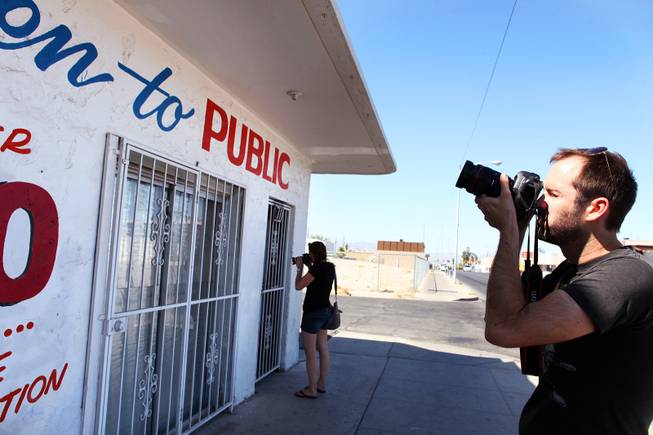
Geoffrey Ellis of the Vegas Vernacular Project photographs an area near Main Street and Bonanza Road in downtown Las Vegas on Thursday, June 14, 2012.
Saturday, June 16, 2012 | 2 a.m.
Geoffrey Ellis and a crew of three volunteers are on a treasure hunt at North Main Street and Bonanza Road.
At first glance, there doesn’t seem to be much to discover, just a few buildings with names like “Don’t Do It Bail Bonds” and “Arrowhead Radiator Service.” The signs aren’t printed, but hand-painted and filled with slight imperfections. They seem like relics of a forgotten era in the ever-changing landscape of Las Vegas.
It’s those signs that add history and character to buildings that are being eclipsed by time that Ellis and the volunteers are seeking out as part of the Vegas Vernacular Project.
“Look at this, this is the best thing I saw today,” Ellis said about the slightly over-extended plateau in the cursive ‘r’ in 621 North Main St. “They could have had this printed, but it would not be as good.”
The Vegas Vernacular Project was created in March to capture the unique painted and neon signage throughout the ever-changing landscape of Las Vegas. Bryan McCormick, Ellis and Mark Johnson organized the volunteer project that will take approximately 50 photographers, writers and technology specialists to complete. The end result will be a website people can go to and see the history of unique Las Vegas signs before they disappear.
“It was really the idea of building something that was a community project,” McCormick said. “Where we can get as many people involved as possible doing something jointly, as opposed to the many isolated projects people tend to work on out here … and also to preserve what is a unique Vegas city graphically as well.”
The idea for the project began when Las Vegas residents McCormick and Johnson had a discussion on all the unique signs downtown. They figured it could be something they’d work on between their day jobs at some point.
Yet one afternoon, they caught wind of buildings around downtown Las Vegas that will either be torn down or whitewashed for new business. McCormick, who had watched buildings disappear in New York, knew that history would be lost forever if they didn’t act fast.
“There tends to be instantaneous architectural amnesia,” McCormick said. “You just don’t even remember (the old building) because something else is new in its place. That’s the entire point of doing this.”
Johnson said the project struck a special chord with him because he grew up in Las Vegas. He rarely appreciated the uniqueness of the city as a kid, but when he returned home from college, he realized how special it was.
“We've got a cool downtown actually,” Johnson said. “But if it goes the same way the Strip goes, then we will not know what that looks like in time.”
They still needed a photographer, however. That’s when fate intervened. Within two weeks, they ran into Ellis, who had come to document Las Vegas for the Downtown Project, a group that focuses solely on community projects in large cities across the United States. The project aligned with what Ellis was already doing, so he offered to help.
They then began enlisting volunteers by contacting photographers throughout the area interested in the project. Volunteer Nick Leonard, 19, said the project was a perfect fit for his interests.
“It’s just an amazing feeling to document (the signs) before they’re gone, because they go quickly,” Leonard said. “Hopefully it will make people realize preserving some things isn’t a bad idea.”
Other companies have begun to pitch in as well. The Plaza hotel-casino offered a free office space on the third floor of its hotel, Box.com offered a terabyte of storage space on Cloud, and Adobe gave them free access to photo-editing software.
McCormick said the project still has a long way to go and won’t be completed until late fall. A large map of downtown Las Vegas sits on their office wall with 36 sectors all still needing to be documented. There will be thousands of photos that need to be edited and coded, and writers to be enlisted to document the history behind the signs.
When all is said and done, however, McCormick envisions a constantly growing and changing website, just like the city. Every photo will be coded with its geographical location. That way people can add photos of signs they might have from various points in the city’s history as well.
“We want to show there is a much deeper history here,” McCormick said. “At first glance everyone says there is no history here, but that’s not true. It’s just not known or obvious.”
Just like the buildings along North Main Street — all it takes is a closer look.
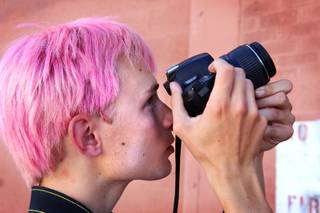
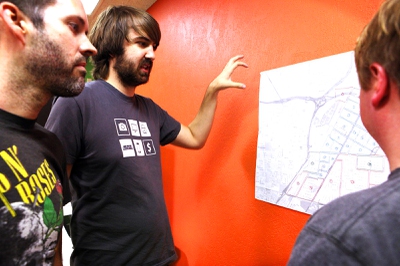
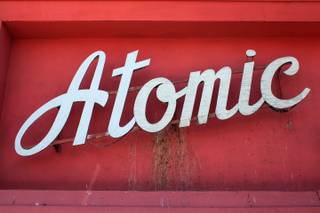
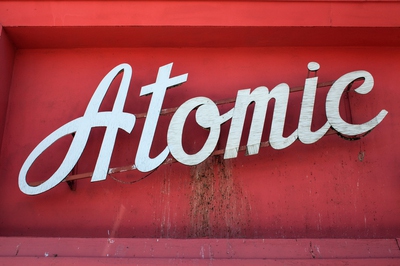

Join the Discussion:
Check this out for a full explanation of our conversion to the LiveFyre commenting system and instructions on how to sign up for an account.
Full comments policy